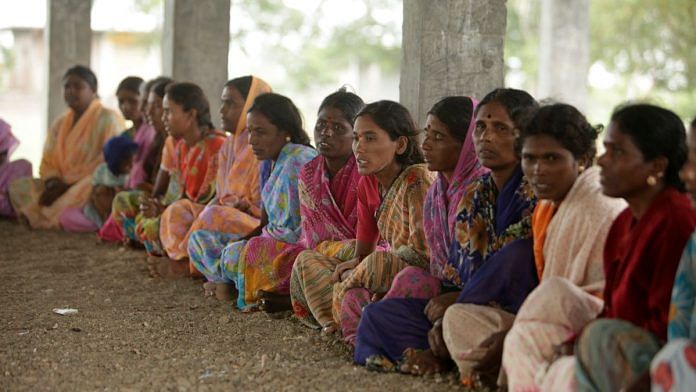New Delhi: India fell by 28 positions to 140 out of 156 countries in the World Economic Forum’s Global Gender Gap Report released this week.
The Global Gender Gap Report is among many other global rankings reports, such as the Press Freedom Index, Human Freedom Index, Global Hunger Index and others, where India has fared badly, and has been handed a poor report card.
In episode 715 of ‘Cut the Clutter‘, Editor-in-Chief Shekhar Gupta highlighted the key findings of the WEF report, how this ranking was determined and asked if India should read a global conspiracy into all these serial downgrades.
India’s report card
All of India’s immediate neighbours, except Pakistan, performed better than India in the WEF’s global gender report. Bangladesh was ranked 65, while Nepal is at 106. Bhutan is at 130 and Sri Lanka at 116. Pakistan’s rank is 153 while Afghanistan has the lowest rank at 156.
Last year, India’s overall gender closing gap stood at 62.5 per cent, and WEF estimates India will need 265 years to close this gap, said Gupta.
Over the years, India’s rank has slipped — it got 98th position in 2006 when the rankings first started. Last year, India was 112 and it is now at 140.
Also read: How India can benefit from the ongoing feminisation of agricultural workforce
How WEF’s gender index is determined
The World Economic Forum ranks countries by looking at four sub-indices or parameters to arrive at a result — economic participation and opportunity, educational participation and opportunity, health and survival and political empowerment.
To attain gender equality, a country has to close gender gaps on all four parameters. However, no country in the world has been able to do that yet. The best performing country — Iceland — has closed the gender gap by 89.2 per cent, revealed Gupta.
According to the report, India has declined by 3 per cent in terms of offering men and women equality in economic participation and opportunity. So from 35.6 per cent, India has come to 32.6 per cent of closing the gap.
India has also slipped in labour force participation from 24.8 per cent to 22.3 per cent. Furthermore, only 14.6 per cent women occupy senior managerial position in India, and only 8.9 per cent when it comes to top management, CEO positions. “For every five rupees that men earn in India, women earn only one. Indian women’s earnings are only 20.7 per cent of men’s,” explained Shekhar Gupta.
On the health survival index, India’s gender gap is at 93.7 per cent. “You would think 93.7 per cent is fantastic news, it is not. It only means women have 6.3 per cent less chance of surviving or getting healthcare as opposed to men. It puts India in the bottom five of the world,” Gupta explained.
13.5 percentage points decline on political empowerment
“India has gone down from 23.1 per cent (already very poor) to 9.1 per cent in political empowerment. This is a shame for a country that is a classical democracy and has fair elections. All this means is that parties themselves are not fielding enough women or giving them enough chance to be in power or to be in politics,” said Gupta.
One silver lining in India’s performance has been the enrolment of female students in primary, secondary and tertiary classes which compares with the best countries in the world, added Gupta.
Also read: Girls’ education is not a demand problem, it’s a supply problem — of schools, jobs, info
Other reports
India has performed poorly in several other major surveys published this year. On the Human Freedom Index, it is down from 94 rank to 111 and down from 79 in economic freedom to 105, Gupta said.
India’s rankings have also worsened in the UNDP’s Human Development Index — from 129 to 131. On the Press Freedom Index, India is down from 140 to 142. India’s ranking on the Global Hunger Index has also declined from 94 to 102.
The national Family Health Survey data tells you that for the first time in 20 years, since 1998-99, India has reversed the improvement it was making in its Child Nutrition status — and this is the Government of India’s own official survey, pointed out Gupta.
Gupta then referred to allegations that foreign agencies and countries are opposed to India and therefore the country is being downgraded in these surveys. Gupta dismissed such claims.
“Foreign countries are not out to get India. They don’t want to bury a one giant hatchet into India’s back. We celebrate when the same countries award us. We celebrated the Kotler award, and an award given by Boston-based firm Fira to Narendra Modi. The same Freedom House report (on freedom and democracy) that downgraded India, also downgraded America substantially,” added Gupta.
Watch the full episode here:
Also read: Indian education’s new digital wave after Covid left behind women







India is still a largely feudal society, whose cultural moorings are still stuck somewhere in the 12th century, which perpetuates its egregious patriarchal, paternalistic, misogynistic, male-dominated attitudes, mores and mindset. Unless women as a group, in this country, refuse to let men define who and what they are, and claim their right to equality before the law as enshrined in the constitution, then they will continue to be seen as men’s chattel…their property.
Western metrics don’t necessarily apply on India.